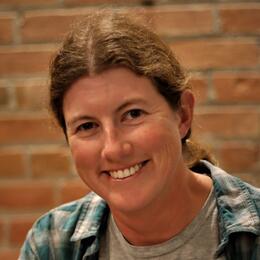Time flies during the nesting season. It seems that only yesterday breeding species were just arriving and beginning to court, but now eggs and chicks dot the coast. Here are just a few of the birds the coastal staff have come across while monitoring nesting birds in 2014.
Brown Pelicans are one of the first species to begin nesting, so many pairs already have chicks. Chicks hatch without down, but start to grow white fuzz in a couple of weeks. At one month of age, around halfway to fledging, their down makes them resemble ungainly little lambs. Until they develop a good coat of down, they cannot regulate their own body temperature, so the attentive parents must brood them (sit on them) to keep them warm and shade them to keep them cool.
Royal Terns are the opposite of pelicans. Their chicks hatch out downy and can stand up within a day or so of hatching. However, they usually stay in the nest scrape for a week or so. When they get bigger they from a chick herd called a creche. The creche is tended to by some of the colony's adults while the rest keep busy bringing in fish for their chicks. But all that lies ahead for this Royal Tern, which is still incubating its egg.
An unusual entry into the Audubon sanctuaries was this Black-necked Stilt, the first on record breeding on Shellbed Island. They are usually found nesting a few miles up the Cape Fear River, at Eagles Island IBA.
Though Black Ducks aren't a management focus for Audubon's nesting islands, we do have a few that nest every year on North Pelican Island on the Cape Fear River. We found this nest while maintaining the signage one day. The mother duck burst off the nest. Otherwise, we would never have noticed her secluded nursery.
Lea-Hutaff Island's Piping Plover pair hatched its nest recently, and this is one of their chicks. It started feeding itself on the day it hatched while its parents kept a watchful eye and led it to promising foraging areas. Unlike many of the birds that use Audubon's islands, plovers are not colonial. They are solitary nesters. Each pair defends its own territory and excludes other plovers.
Another species of plover uses Lea-Hutaff: the Wilson's Plover. These chicks also feed themselves from day one.
These Great Egret chicks were on Morgan Island, a North Carolina Wildlife Resources Commission island near Harker's Island. Audubon staff was able to help census the site in May. Along with the Great Egrets were many Little Blue Herons and White Ibis.
White Ibis lay two to three spotty eggs in seeming ramshackle nests that nevertheless mange to support the eggs, the adults and eventually large chicks. Females do most of the nest construction, and males bring in the sticks. They usually add leaves and other foliage to complete the nests, which are always stronger than they look. Although their parents are white, the chicks hatch out with black down and fledge with brown backs and white bellies. They molt into their white feathers by the end of their second year.
Last, this is a Gull-billed Tern nest. Unlike other terns, which dive headfirst into the water for fish, the Gull-billed Tern favors crabs, lizards and other terrestrial prey. That is a lizard tail protruding from the mouth of the chick on the left (likely a six-lined racerunner). About 30 pairs nest on the Cape Fear River; fewer than 200 pairs nest in the state and there are around 4,000 pairs on the Atlantic and Gulf coasts of the U.S.




